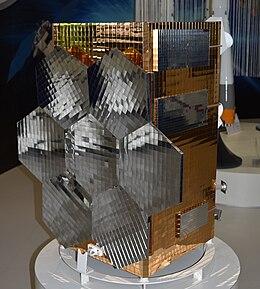cosmos.wikisort.org - Spacecraft
Mikhailo Lomonosov (MVL-300, or Mikhailo, or more commonly Lomonosov; MVL stands for Mikhail Vasilyevich Lomonosov[4]) is an astronomical satellite operated by Moscow State University (MSU) named after Mikhail Lomonosov.[5]
This article may be expanded with text translated from the corresponding article in French. (April 2016) Click [show] for important translation instructions.
|
 A model of the Mikhailo Lomonosov | |||||||||||||||||||
| Mission type | Astronomy | ||||||||||||||||||
|---|---|---|---|---|---|---|---|---|---|---|---|---|---|---|---|---|---|---|---|
| Operator | MSU | ||||||||||||||||||
| COSPAR ID | 2016-026A | ||||||||||||||||||
| SATCAT no. | 41464 | ||||||||||||||||||
| Website | lomonosov.sinp.msu.ru | ||||||||||||||||||
| Mission duration | Planned: 3 years [1] | ||||||||||||||||||
| Spacecraft properties | |||||||||||||||||||
| Manufacturer | VNIIEM | ||||||||||||||||||
| Launch mass | 620 kg (1,370 lb)[1] | ||||||||||||||||||
| Payload mass | 170 kg (370 lb)[1] | ||||||||||||||||||
| Power | ~300 W[1] | ||||||||||||||||||
| Start of mission | |||||||||||||||||||
| Launch date | 28 April 2016, 02:01 UTC | ||||||||||||||||||
| Rocket | Soyuz-2.1a/Volga | ||||||||||||||||||
| Launch site | Vostochny Site 1S | ||||||||||||||||||
| Contractor | Roscosmos | ||||||||||||||||||
| End of mission | |||||||||||||||||||
| Deactivated | 14 January 2019 | ||||||||||||||||||
| Orbital parameters | |||||||||||||||||||
| Reference system | Geocentric | ||||||||||||||||||
| Regime | Sun-synchronous | ||||||||||||||||||
| Semi-major axis | 6,856 kilometers (4,260 mi)[2] | ||||||||||||||||||
| Perigee altitude | 478.2 km (297.1 mi)[2] | ||||||||||||||||||
| Apogee altitude | 492.9 km (306.3 mi)[2] | ||||||||||||||||||
| Inclination | 97.3 degrees[2] | ||||||||||||||||||
| Period | 94.2 minutes[2] | ||||||||||||||||||
| |||||||||||||||||||
Mission
The objective of the mission is the observation of gamma-ray bursts, high-energy cosmic rays and transient phenomena in the Earth's upper atmosphere.[5]
Launch
The mission launch was initially planned for 2011 when 300 years since the birthday of Mikhail Lomonosov was celebrated.[6] After several postponements the mission was finally launched on 28 April 2016 from Vostochny Cosmodrome by the Soyuz 2.1a launch vehicle.[7]
Scientific payload
The spacecraft is equipped with seven scientific instruments:[4][1]
- Tracking Ultraviolet Set Up system (TUS) was designed to measure fluorescence light radiated by EAS (Extensive Air Showers) of Ultra High Energy Cosmic Rays (UHECR) in the Earth atmosphere as well as for transients' studies within UV-range. This was the first space based instrument dedicated to these phenomena. The TUS-project started in 2001.[8]
- Block for X-ray and gamma-radiation detection (BDRG) is intended for detecting and monitoring gamma-ray bursts and for producing a trigger signal for ShOK cameras (see below);
- UFFO consists of X-ray and 10 cm UV telescopes intended for studying gamma-ray bursts;
- Optic cameras of super-wide field of vision (ShOK) is a pair of wide-field optical cameras, which main purpose is a prompt detection of the optical radiation of gamma-ray bursts after receiving trigger signals from BDRG;
- Dosimeter of Electrons, PROtons and Neutrons (DEPRON) measures absorbed doses and spectra of electrons, protons, neutrons and heavy nuclei;
- Electron Loss and Fields Investigator for Lomonosov (ELFIN-L) comprises the Energetic Particle Detector for Electrons (EPDE), Energetic Proton Detector for Ions (EPDI) and Flux Gate Magnetometer (FGM). Its main purposes is to study energetic particles in the Earth magnetosphere;
- IMISS-1 is a device intended to test microelectromechanical inertial modules.
End of mission
The TUS-telescope aboard Lomonosov stopped data collection in late 2017.[8]
On June 30, 2018, it was published that the Lomonosov-satellite had suffered a malfunction in its data transmission system. Attempts to fix the problem were underway, but fixing the problem had so far been unsuccessful.[9]
As of 14 January 2019, the problems had not been solved and all the scientific equipment of the satellite were powered off. The recovery attempts continued (some systems of the satellite were responsive, the problem was with scientific payload systems). Before succumbing to these difficulties, the satellite had worked for one and a half years for its intended purpose. With the failure of the Lomonosov satellite and the Spektr-R end of mission on 30 May 2019, the Russian space program lost both of its scientific satellites until the launch of Spektr-RG in July 2019.
References
- "Космический аппарат "Ломоносов"" [The spacecraft "Lomonosov"] (in Russian). VNIIEM. Retrieved 21 March 2016.
- "MVL 300 Satellite details 2016-026A NORAD 41464". N2YO. 4 May 2016. Retrieved 4 May 2016.
- ELFIN-L consists of three components: a flux gate magnetometer (FGM), an electron particle detector (EPDE), and an ion proton detector (EPDI)
- "MVL-300 (Mikhailo Lomonosov)". Gunter's Space Page. Retrieved 21 March 2016.
- "Soyuz prepared for first flight from Siberian cosmodrome". Spaceflight Now. Retrieved 21 March 2016.
- "Садовничий: спутник "Михайло Ломоносов" будет запущен в 2011 году" ["Mihailo Lomonosov" satellite to be launched in 2011]. Ria Novosti (in Russian). 26 January 2010. Retrieved 5 February 2017.
- "Первый пуск с Восточного прошёл успешно!" [The first launch from the East has been successful!] (in Russian). Roscosmos. 28 April 2016. Retrieved 2017-02-05.
- Khrenov, B.A.; Garipov, G.K.; Kaznacheeva, M.A.; Klimov, P.A.; Panasyuk, M.I.; Petrov, V.L.; Sharakin, S.A.; Shirokov, A.V.; Yashin, I.V.; Zotov, M.Yu.; Grinyuk, A.A.; Grebenyuk, V.M.; Lavrova, M.V.; Tkachev, L.G.; Tkachenko, A.V.; Saprykin, O.A.; Botvinko, A.A.; Senkovsky, A.N.; Puchkov, A.E.; Bertaina, M.; Golzio, A. (2020). "An extensive-air-shower-like event registered with the TUS orbital detector". Journal of Cosmology and Astroparticle Physics. 2020 (3): 033. arXiv:1907.06028. Bibcode:2020JCAP...03..033K. doi:10.1088/1475-7516/2020/03/033. S2CID 196621883.
- "Mikhailo Lomonosov". russianspaceweb.com.
External links
На других языках
[de] Michail Lomonossow (Satellit)
Michail Lomonossow (MVL-300) ist ein russisches Weltraumteleskop zur Untersuchung hochenergetischer Strahlung. Es wurde nach dem russischen Naturwissenschaftler Michail Wassiljewitsch Lomonossow benannt, wobei die Bezeichnung MVL-300 auf das etwa 300 Jahre zurückliegende Geburtsjahr des Forschers hinweist.[2]- [en] Mikhailo Lomonosov (satellite)
[ru] Михайло Ломоносов (спутник)
«Миха́йло Ломоно́сов» — российский научный спутник, предназначенный для исследования транзиентных световых явлений верхней атмосферы Земли, радиационных характеристик земной магнитосферы и для фундаментальных космологических исследований.Другой контент может иметь иную лицензию. Перед использованием материалов сайта WikiSort.org внимательно изучите правила лицензирования конкретных элементов наполнения сайта.
WikiSort.org - проект по пересортировке и дополнению контента Википедии